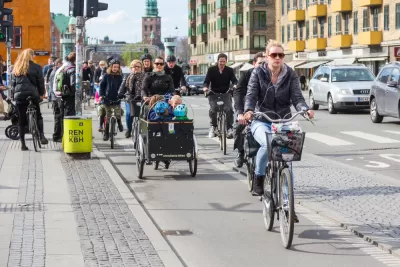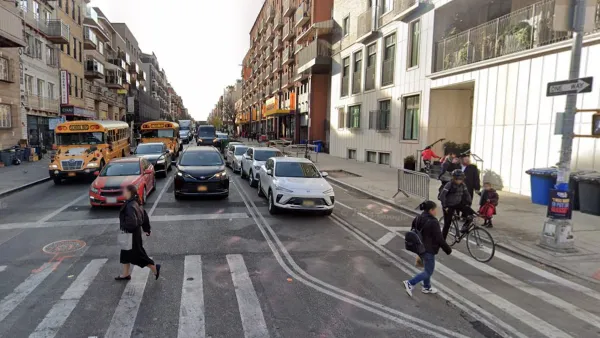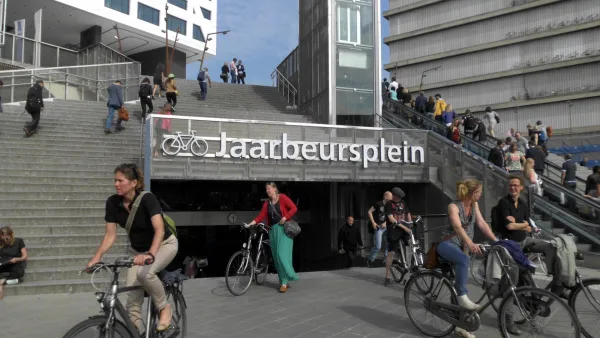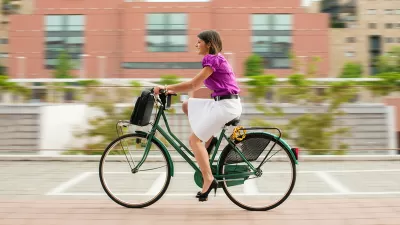Key to explaining the popularity of biking in Copenhagen is its cultural attitude, which is also based on sound cost-benefit analysis. Until Americans change how they value transport modes, protected bike lanes may be elusive.

"In a new paper, Stefan Gössling from Lund University and Andy Choi from the University of Queensland take a look at Copenhagen's approach and argue that it explains how the city has built out so much dedicated cycling infrastructure, including miles of uninterrupted and separated bike lanes, and even dedicated bike tunnels, bridges, and traffic lights," writes Ben Schiller for Fast Company.
The study, "Transport transitions in Copenhagen: Comparing the cost of cars and bicycles," published in the May 2015 issue of Ecological Economics, is focused primarily on costs of two modes of transport: bicycling and driving. "It is the first time a price has been put on car use as compared to cycling," states Science News.
From report's abstract:
In many cities of the world, bicycle infrastructure projects are implemented to foster more sustainable transportation systems. However, such projects have often raised questions regarding their public funding, as they entail considerable costs. This paper reviews cost–benefit analysis (CBA) frameworks as these are presently used to assess bicycle infrastructure projects.
"When the city decides on a cycling project, it compares the cost to that of a road for cars, and it includes not only the upfront amount, but also things like the cost of road accidents to society, the impact of car pollution on health, and the cost of carbon emitted to the atmosphere," writes Shiller.
After including these factors, it comes to a rather startling calculation. One kilometer driven by car costs society about 17 cents (15 euro cents), whereas society gains 18 cents (16 euro cents) for each kilometer cycled, the paper finds. That's because of factors like the health benefits of cycling and the avoided ill-effects of cars.
Finally, protected bike lanes play a key role, asserts one of the report's author.
"If we want people to cycle, then we have to change our approach towards urban infrastructure. Cyclists will only cycle [in large numbers] when they feel physically safe and when it's fast, which means they need to be physically separated from cars," Stefan Gössling says.
Hat tip to Len Conly, Sierra Club Transportation Committee
FULL STORY: How Copenhagen Became A Cycling Paradise By Considering The Full Cost Of Cars

Planetizen Federal Action Tracker
A weekly monitor of how Trump’s orders and actions are impacting planners and planning in America.

Map: Where Senate Republicans Want to Sell Your Public Lands
For public land advocates, the Senate Republicans’ proposal to sell millions of acres of public land in the West is “the biggest fight of their careers.”

Restaurant Patios Were a Pandemic Win — Why Were They so Hard to Keep?
Social distancing requirements and changes in travel patterns prompted cities to pilot new uses for street and sidewalk space. Then it got complicated.

Platform Pilsner: Vancouver Transit Agency Releases... a Beer?
TransLink will receive a portion of every sale of the four-pack.

Toronto Weighs Cheaper Transit, Parking Hikes for Major Events
Special event rates would take effect during large festivals, sports games and concerts to ‘discourage driving, manage congestion and free up space for transit.”

Berlin to Consider Car-Free Zone Larger Than Manhattan
The area bound by the 22-mile Ringbahn would still allow 12 uses of a private automobile per year per person, and several other exemptions.
Urban Design for Planners 1: Software Tools
This six-course series explores essential urban design concepts using open source software and equips planners with the tools they need to participate fully in the urban design process.
Planning for Universal Design
Learn the tools for implementing Universal Design in planning regulations.
Heyer Gruel & Associates PA
JM Goldson LLC
Custer County Colorado
City of Camden Redevelopment Agency
City of Astoria
Transportation Research & Education Center (TREC) at Portland State University
Camden Redevelopment Agency
City of Claremont
Municipality of Princeton (NJ)





























